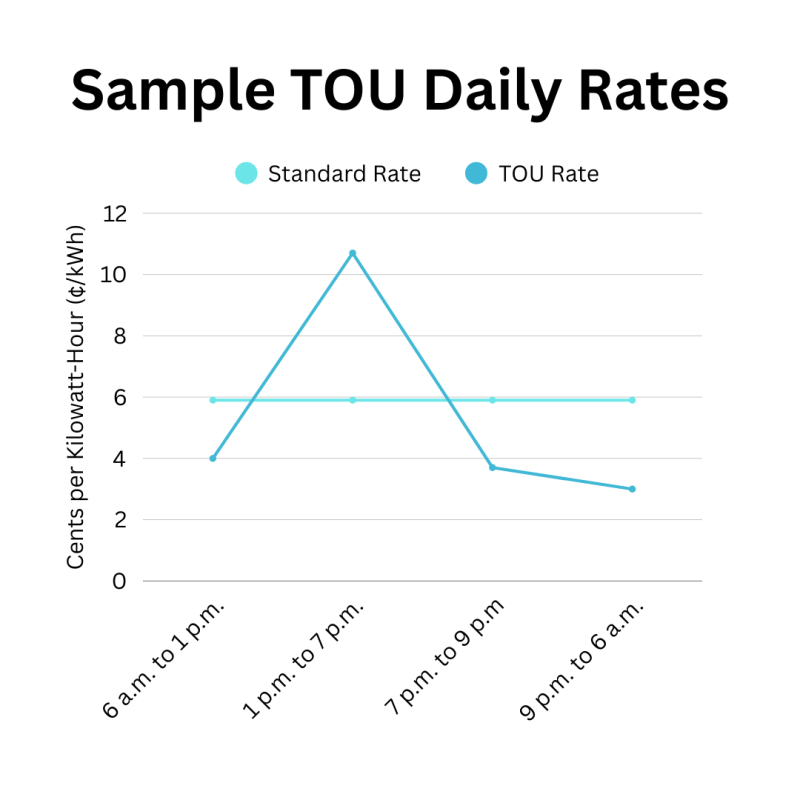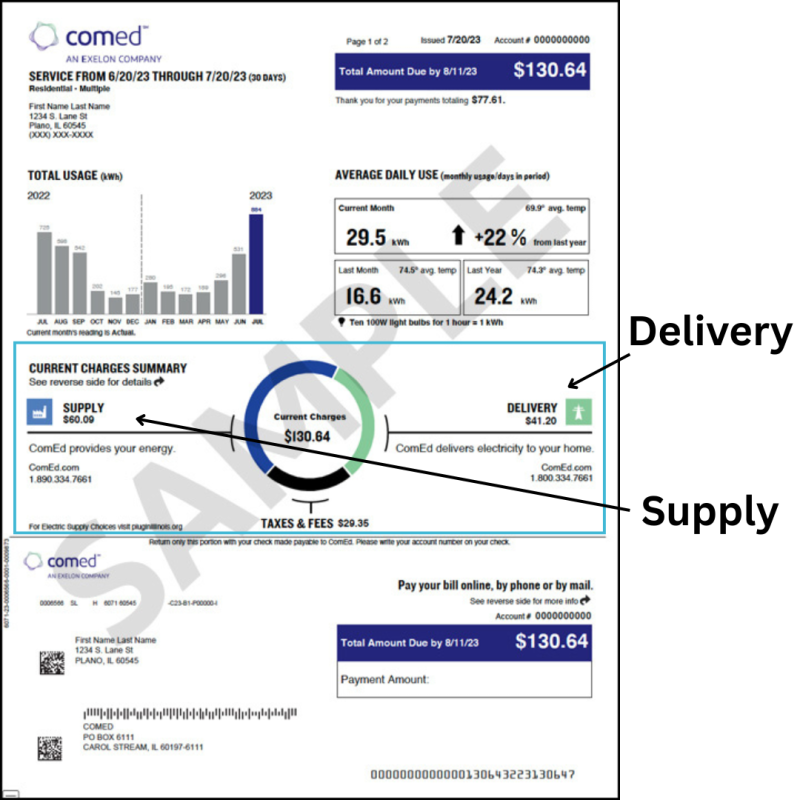Next year, ComEd customers will have the option of signing up for a “time-of-use” rate, or TOU, that can help them save money while reducing strain on the power system.
The Climate and Equitable Jobs Act (CEJA), which CUB supported, required ComEd to offer such a rate, and under a January ruling (Docket No. 24-0378) by the Illinois Commerce Commission (ICC), ComEd will launch the TOU in 2026.
There are still a lot of details that need to be worked out, but CUB hopes this Q&A gives you an introduction:
What is a time-of-use (TOU) rate?
Under traditional electric rates, customers pay the same amount per kilowatt-hour, regardless of when they use their electricity. While this approach is straightforward, it is a far-from-accurate method of assigning costs, and many people end up paying more than they should.
A TOU rate, on the other hand, breaks the day into set periods, with each period charging customers a different rate for electricity. Overnight, when demand is the lowest, the price is much lower than the standard rate customers ordinarily pay. The hours that tend to have the highest demand–In Illinois, that’s the late afternoon and early evening–will cost the most. The rest of the day, the rate is higher than overnight but still lower than the standard rate. So if you avoid using too much during the peak hours, you save money, and whatever you can shift to overnight is especially low-cost.
TOU rates fall under the umbrella of “demand response” programs. The idea is to give people a financial incentive–a lower rate for electricity–to shift the bulk of their usage away from high-demand times. Shifting electric demand away from peak hours has several financial and environmental benefits.
What part of the bill does a TOU rate impact?
Your bill is generally divided into two sections: supply rates (what we pay for the actual electricity) and delivery (what we pay the utility to deliver electricity to us). TOU rates can cover supply, delivery or both.
In recent years, ComEd did offer a pilot program–from 2020 to 2024– with a TOU supply rate. (Canary Media reports that the pilot program reduced peak demand between 6.5 percent and 9.7 percent in the summer.) In January, state regulators approved a TOU rate that would only apply to the delivery side of bills–but ComEd wants to offer a combined delivery and supply TOU rate option as well. (More on this below.)
Why do people like TOU rates?
People are attracted to the idea that relatively easy shifts in their electricity usage can help them lower their utility bills. Also, reducing peak demand on the grid lowers energy prices for everyone in the long run. TOU rates also are good for the environment: Lowering demand helps the grid avoid having to run its most expensive and dirtiest gas and coal plants. Combined with other measures, TOU rates can help delay or avoid altogether the need to build more pricey power plants or replace or upgrade electric grid equipment.

ComEd’s TOU delivery rate would save customers money most periods of the day–except for a peak period of 10.7 cents per kWh. “The key to savings will be customers limiting usage from 1 pm to 7 pm,” a ComEd spokesman says.
How will ComEd’s proposed TOU rate work?
Canary Media reported that most standard customers are set to pay an energy-delivery charge of about 5.9 cents per kilowatt-hour next year. But ComEd anticipates participants in the proposed time-of-use rate will pay something more like these tentative projected delivery rates:
- 6 a.m. to 1 p.m.: 4 cents per kilowatt-hour (kWh)
- 1 p.m. to 7 p.m. 10.7 cents per kWh
- 7 p.m. to 9 p.m.: 3.7 cents per kWh
- 9 p.m. to 6 a.m. 3 cents per kWh
Caution: The final TOU rates could be different (see “What’s next,” below). As you see with these preliminary rates, most of the times offer a delivery rate that is significantly lower than ComEd’s standard rate. The one exception, highlighted above, is the peak delivery rate of 10.7 cents per kWh during a time period when electricity demand is typically highest. “The key to savings will be customers limiting usage from 1 pm to 7 pm,” a ComEd spokesman told Canary Media.
How is ComEd’s TOU rate different from the utility’s Hourly Pricing program?
ComEd offers another time-variant rate, Hourly Pricing, which charges customers a supply price that can change by the hour. If your usage is less peak-hour-intensive than most customers, Hourly Pricing will save you money in the average month. But not everyone is comfortable with a supply rate that changes hourly.
A TOU rate, with its set pricing during predetermined time periods, can give participants more certainty and clarity on what they’re paying throughout the day. It’s designed to take the guesswork out: In the case of the TOU rate outlined above, you can be certain to save money if you avoid the peak hours (1 p.m. to 7 p.m.) and shift what usage you can to overnight (10 p.m. to 6 a.m. here).
ComEd also offers a Peak Time Savings plan, which gives people a credit on their bill if they’re able to reduce their usage during certain peak-demand periods in the summer. Because this program contains no risk of participants paying extra, CUB recommends it to everyone.
Does CUB support the TOU?
Yes, a delivery TOU rate will be a good, money-saving option for a lot of consumers. While CUB would have preferred a shorter peak period, we were pleased overall with January’s ICC decision and that consumers will have more choices in the market.
Since that ruling, ComEd now wants to also offer customers a TOU option that includes delivery and supply rates. More on that below.

ComEd’s TOU rate options will include 1) a delivery-only rate and 2) an option with both supply and delivery TOU rates.
What’s next?
We’re not across the finish line yet. ComEd filed a petition for rehearing in the TOU case before the ICC, requesting that regulators also approve a combined delivery AND supply TOU rate.
We support giving consumers more money-saving choices in the market, but the devil is always in the details, so this development merits more explanation. A couple notes:
- Under ComEd’s proposal, customers could enroll in either a delivery TOU rate or a combined option that includes delivery AND supply TOU rates. (There would be no supply-only TOU rate.)
- The combined TOU option would have the same rate-period hours as the delivery TOU rate. The final rates have not yet been announced, but they’re expected to have a wider difference between peak periods and non-peak periods.
- The combined TOU option could potentially save participants more money, which makes it attractive. However, the delivery-only TOU rate may be better for customers who want a smaller difference between rates, and thus a lower risk of losing money if on certain days they can’t avoid using more energy during the peak period.
- The delivery-only TOU rate also could be a good choice for somebody who wants to explore other options for the supply side of their bills, such as Hourly Pricing.
- Finally, the delivery-only TOU also won’t include extra charges that ComEd is now proposing to include in the combined supply/delivery TOU rates.
What extra charges is ComEd trying to include in the combined (supply AND delivery) TOU rate?
As we said before, CUB supports having these TOU options. But we do take issue with part of ComEd’s proposal: The utility wants to include in the combined TOU rate option the same volatile Capacity Charge that Hourly Pricing customers pay–as well as a similarly unpredictable transmission charge. In its previous pilot program, ComEd also proposed including the Capacity Charge, but the ICC rejected it.
CUB and ComEd are now rehashing that debate before the ICC. We hope we win, but whatever the outcome of that battle, the delivery-only TOU rate will not include these separate fixed charges. Stay tuned for future developments!

